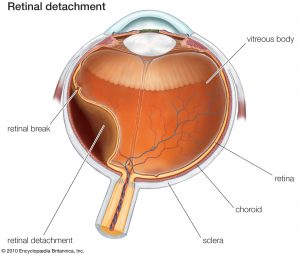In the past six months, Drs. Cheryl and Dave Roell have seen an increase in retinal detachment cases with patients who also have high myopia (extreme nearsightedness) at their All About Eyes office in Egg Harbor Township, New Jersey.
“I’ve been trying to educate all my high myopes on the seriousness of [retinal detachment] and to call the office as soon as possible if any symptoms appear,” says Dr. Roell.
What is Retinal Detachment?
The retina is a thin layer of nerve tissue located at the back of the eye next to the optic nerve. Its function is to receive light signals from the eye’s lens and transmit that signal to the brain. It can detach or tear away from the eye and may lead to permanent vision loss unless it is corrected. The National Eye Institute says that if you notice a sudden increase in the floaters in your eyes, flashes of light in one or both eyes, or a grey shadow in your field of vision, those are all signs of retinal detachment and need to be addressed immediately. Call your eye doctor or go to the emergency room for further evaluation. Treatment depends on the severity of the detachment. Laser surgery and freezing treatments can usually be done at the doctor’s office to repair the tear. More serious cases will likely require surgery at a hospital.
Why ‘High Myopes’ are at Risk of Retinal Detachment
Myopia, also known as nearsightedness, can be due to an elongated eye-shape rather than a round one. A study from the American Journal of Epidemiology found that “55% of non-traumatic detachments in eyes without previous surgery are attributable to myopia” due to the architecture of the eye itself.
Cases of myopia are on the rise around the world. The American Optometric Association’s (AOA) 2018 study found that childhood rates are increasing with one-in-four parents having a child with myopia between the ages of 3 and 12. This represents a 25% increase from just 40 years ago.
“While being nearsighted may not sound serious, if the condition is not managed properly, it can lead to major issues throughout [children’s] school years into adulthood. If left untreated over time, it can put the eyes at risk for a number of vision-threatening conditions including retinal detachment, early cataract development, macular degeneration, glaucoma, and even blindness. Although the specific myogenic spark has yet to be identified, there is significant evidence that the tendency to develop the condition can be caused by genetics, environmental factors or other health problems. Additionally, individuals who spend considerable time engaged in ‘near’ activities, like reading, working at a computer or using hand-held electronics, may be more likely to develop myopia.” — American Optometric Association
Dr. Roell concurs. “Now that so many kids are becoming myopic, I think it’s really important that people understand this condition.”


